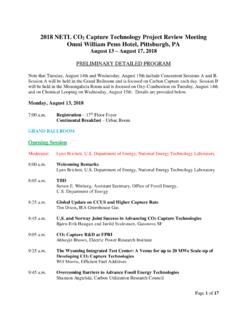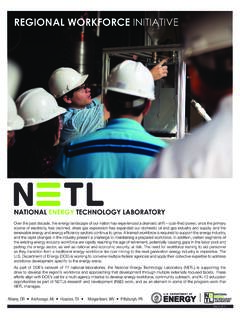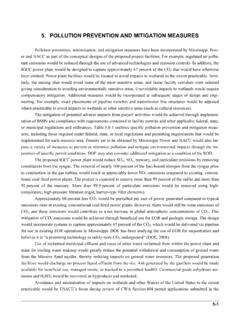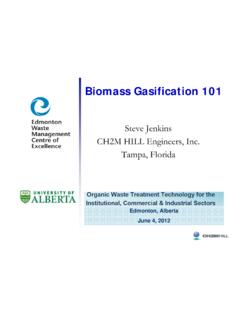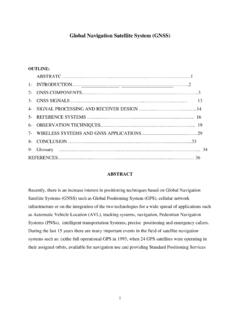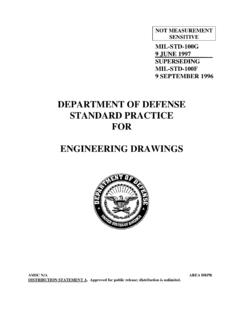Transcription of Fuel Cell Handbook (Seventh Edition)
1 Fuel Cell Handbook (Seventh Edition) By EG&G Technical Services, Inc. Under Contract No. DE-AM26-99FT40575 Department of Energy Office of Fossil Energy National Energy Technology Laboratory Box 880 Morgantown, West Virginia 26507-0880 November 2004 DISCLAIMER This report was prepared as an account of work sponsored by an agency of the United States Government. Neither the United States Government nor any agency thereof, nor any of their employees, makes any warranty, express or implied, or assumes any legal liability or respon-sibility for the accuracy, completeness, or usefulness of any information, apparatus, product, or process disclosed, or represents that its use would not infringe privately owned rights. Reference herein to any specific commercial product, process, or service by trade name, trademark, manu-facturer, or otherwise does not necessarily constitute or imply its endorsement, recommendation, or favoring by the United States Government or any agency thereof.
2 The views and opinions of authors expressed herein do not necessarily state or reflect those of the United States Govern-ment or any agency thereof. Available to DOE and DOE contractors from the Office of Scientific and Technical Information, Box 62, 175 Oak Ridge Turnpike, Oak Ridge, TN 37831; prices available at (423) 576-8401, fax: (423) 576-5725, E-mail: Available to the public from the National Technical Information Service, Department of Commerce, 5285 Port Royal Road, Springfield, VA 22161; phone orders accepted at (703) 487-4650. iii TABLE OF CONTENTS Section Title Page 1. TECHNOLOGY OVERVIEW .. 1-1 1-1 UNIT 1-2 Basic Structure .. 1-2 Critical Functions of Cell Components .. 1-3 FUEL CELL 1-4 Planar-Bipolar Stacking.
3 1-4 Stacks with Tubular Cells .. 1-5 FUEL CELL 1-5 FUEL CELL 1-7 Polymer Electrolyte Fuel Cell (PEFC).. 1-9 Alkaline Fuel Cell (AFC) .. 1-10 Phosphoric Acid Fuel Cell (PAFC).. 1-10 Molten Carbonate Fuel Cell (MCFC) .. 1-11 Solid Oxide Fuel Cell (SOFC) .. 1-12 1-12 1-14 APPLICATIONS, DEMONSTRATIONS, AND 1-15 Stationary Electric 1-15 Distributed Generation .. 1-20 Vehicle Motive 1-22 Space and Other Closed Environment Power .. 1-23 Auxiliary Power Systems .. 1-23 Derivative 1-32 1-32 2. FUEL CELL PERFORMANCE .. 2-1 THE ROLE OF GIBBS FREE ENERGY AND NERNST 2-1 IDEAL 2-4 CELL ENERGY 2-7 CELL 2-7 ACTUAL 2-10 FUEL CELL PERFORMANCE 2-18 MATHEMATICAL 2-24 Value-in-Use Models .. 2-26 Application Models .. 2-27 Thermodynamic System 2-27 3-D Cell / Stack Models .. 2-29 1-D Cell Models .. 2-31 Electrode 2-32 2-33 3. POLYMER ELECTROLYTE FUEL CELLS.
4 3-1 CELL 3-1 State-of-the-Art Components .. 3-2 Component 3-11 3-14 iv PEFC 3-16 Direct Hydrogen PEFC Systems .. 3-16 Reformer-Based PEFC 3-17 Direct Methanol Fuel Cell Systems .. 3-19 PEFC 3-21 Transportation Applications .. 3-21 Stationary Applications .. 3-22 3-22 4. ALKALINE FUEL 4-1 CELL 4-5 State-of-the-Art Components .. 4-5 Development Components .. 4-6 4-7 Effect of Pressure .. 4-8 Effect of Temperature .. 4-9 Effect of Impurities .. 4-11 Effects of Current 4-12 Effects of Cell Life .. 4-14 SUMMARY OF EQUATIONS FOR AFC .. 4-14 4-16 5. PHOSPHORIC ACID FUEL CELL .. 5-1 CELL 5-2 State-of-the-Art Components .. 5-2 Development Components .. 5-6 5-11 Effect of Pressure .. 5-12 Effect of Temperature .. 5-13 Effect of Reactant Gas Composition and Utilization .. 5-14 Effect of Impurities .. 5-16 Effects of Current 5-19 Effects of Cell Life.
5 5-20 SUMMARY OF EQUATIONS FOR 5-21 5-22 6. MOLTEN CARBONATE FUEL 6-1 CELL 6-4 State-of-the-Art Componments .. 6-4 Development Components .. 6-9 6-13 Effect of Pressure .. 6-15 Effect of Temperature .. 6-19 Effect of Reactant Gas Composition and Utilization .. 6-21 Effect of Impurities .. 6-25 Effects of Current 6-30 Effects of Cell Life .. 6-30 Internal Reforming .. 6-30 SUMMARY OF EQUATIONS FOR 6-34 6-38 v 7. SOLID OXIDE FUEL 7-1 CELL 7-2 Electrolyte Materials .. 7-2 Anode Materials .. 7-3 Cathode Materials .. 7-5 Interconnect 7-6 Seal 7-9 CELL AND STACK 7-13 Tubular SOFC .. 7-13 Performance .. 7-20 Planar 7-31 Single Cell 7-35 Stack 7-39 Stack Scale-Up .. 7-41 SYSTEM 7-45 7-45 8. FUEL CELL 8-1 SYSTEM 8-2 Fuel Processing .. 8-2 POWER 8-27 Introduction to Fuel Cell Power Conditioning 8-28 Fuel Cell Power Conversion for Supplying a Dedicated Load [2,3,4].
6 8-29 Fuel Cell Power Conversion for Supplying Backup Power to a Load Connected to a Local Utility .. 8-34 Fuel Cell Power Conversion for Supplying a Load Operating in Parallel With the Local Utility (Utility Interactive) .. 8-37 Fuel Cell Power Conversion for Connecting Directly to the Local Utility .. 8-37 Power Conditioners for Automotive Fuel Cells .. 8-39 Power Conversion Architecture for a Fuel Cell Turbine Hybrid Interfaced With a Local 8-41 Fuel Cell Ripple Current .. 8-43 System Issues: Power Conversion Cost and 8-44 REFERENCES (Sections and ) .. 8-45 SYSTEM 8-46 Pressure .. 8-46 Temperature .. 8-48 8-49 Heat Recovery .. 8-50 8-51 Concluding Remarks on System Optimization .. 8-51 FUEL CELL SYSTEM 8-52 Natural Gas Fueled PEFC System .. 8-52 Natural Gas Fueled PAFC System .. 8-53 Natural Gas Fueled Internally Reformed MCFC 8-56 Natural Gas Fueled Pressurized SOFC 8-58 Natural Gas Fueled Multi-Stage Solid State Power Plant System.
7 8-62 Coal Fueled SOFC 8-66 Power Generation by Combined Fuel Cell and Gas Turbine System .. 8-70 Heat and Fuel Recovery Cycles .. 8-70 vi FUEL CELL 8-82 Molten Carbonate Fuel Cell Networks: Principles, Analysis and Performance .. 8-82 MCFC 8-86 Recycle Scheme .. 8-86 Reactant Conditioning Between Stacks in 8-86 Higher Total Reactant Utilization .. 8-87 Disadvantages of MCFC 8-88 Comparison of 8-88 Conclusions .. 8-89 8-89 8-89 Projects .. 8-92 World s First Hybrid 8-93 Hybrid Electric Vehicles (HEV) .. 8-93 FUEL CELL AUXILIARY POWER 8-96 System Performance 8-97 Technology Status .. 8-98 System Configuration and Technology Issues .. 8-99 System Cost 8-102 SOFC System Cost Structure .. 8-103 Outlook and Conclusions .. 8-104 8-104 9. SAMPLE CALCULATIONS .. 9-1 UNIT 9-1 Fuel Cell Calculations .. 9-1 Fuel Processing Calculations.
8 9-13 Power Conditioners .. 9-16 Others .. 9-16 SYSTEM 9-16 Efficiency Calculations .. 9-17 Thermodynamic 9-19 SUPPORTING 9-22 COST 9-25 Cost of 9-25 Capital Cost Development .. 9-26 COMMON CONVERSION 9-27 AUTOMOTIVE DESIGN 9-28 9-29 10. APPENDIX .. 10-1 EQUILIBRIUM 10-1 CONTAMINANTS FROM COAL 10-2 SELECTED MAJOR FUEL CELL REFERENCES, 1993 TO 10-4 LIST OF 10-10 FUEL CELL RELATED CODES AND 10-14 Introduction .. 10-14 Organizations .. 10-15 Codes & Standards .. 10-16 Codes and Standards for Fuel Cell 10-17 vii Codes and Standards for the Installation of Fuel Cells .. 10-19 Codes and Standards for Fuel Cell Vehicles .. 10-19 Application 10-19 References .. 10-21 FUEL CELL FIELD SITE 10-21 Worldwide Sites .. 10-21 DoD Field Sites .. 10-24 IFC Field 10-24 FuelCell 10-24 Siemens 10-24 10-31 Introduction .. 10-31 Hydrogen Production.
9 10-32 DOE s Hydrogen Research .. 10-34 Hydrogen 10-35 Barriers .. 10-36 THE OFFICE OF ENERGY EFFICIENCY AND RENEWABLE ENERGY WORK IN FUEL 10-36 RARE EARTH 10-38 Introduction .. 10-38 10-40 10-41 11. INDEX .. 11-1 viii LIST OF FIGURES Figure Title Page Figure 1-1 Schematic of an Individual Fuel 1-2 Figure 1-2 Expanded View of a Basic Fuel Cell Unit in a Fuel Cell Stack (1).. 1-4 Figure 1-3 Fuel Cell Power Plant Major Processes .. 1-7 Figure 1-4 Relative Emissions of PAFC Fuel Cell Power Plants Compared to Stringent Los Angeles Basin Requirements .. 1-13 Figure 1-5 PC-25 Fuel 1-16 Figure 1-6 Combining the SOFC with a Gas Turbine Engine to Improve Efficiency .. 1-19 Figure 1-7 Overview of Fuel Cell Activities Aimed at APU Applications.
10 1-24 Figure 1-8 Overview of APU Applications .. 1-24 Figure 1-9 Overview of typical system 1-25 Figure 1-10 Stage of development for fuel cells for APU applications .. 1-26 Figure 1-11 Overview of subsystems and components for SOFC and PEFC systems .. 1-28 Figure 1-12 Simplified process flow diagram of pre-reformer/SOFC system .. 1-29 Figure 1-13 Multilevel system modeling approach .. 1-30 Figure 1-14 Projected Cost Structure of a 5kWnet APU SOFC System.. 1-32 Figure 2-1 H2/O2 Fuel Cell Ideal Potential as a Function of Temperature .. 2-5 Figure 2-2 Effect of fuel utilization on voltage efficiency and overall cell efficiency for typical SOFC operating conditions (800 C, 50% initial hydrogen concentration).. 2-10 Figure 2-3 Ideal and Actual Fuel Cell Voltage/Current Characteristic .. 2-11 Figure 2-4 Example of a Tafel Plot .. 2-13 Figure 2-5 Example of impedance spectrum of anode-supported SOFC operated at 850 C.

